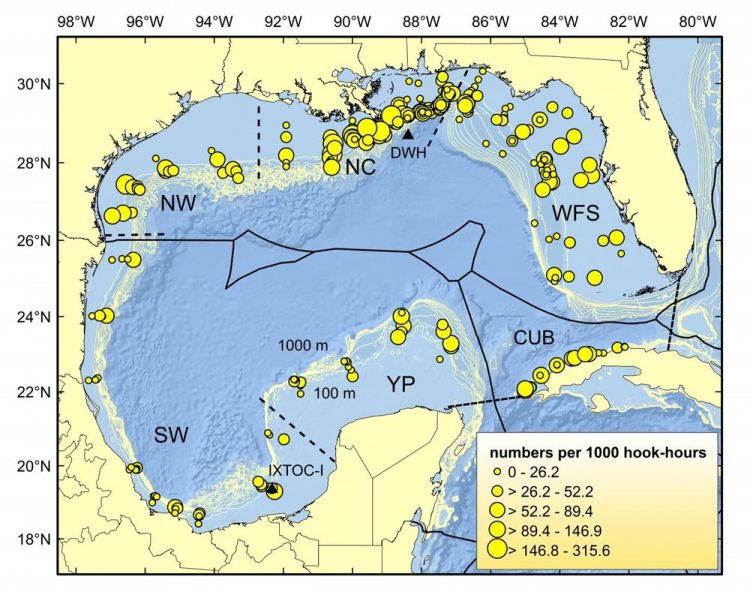New results of Deepwater Horizon research to protect marine life against future oil spills

This map portrays sampling locations and catch rates (number of fish caught per 1000 hooks fished per hour). Credit: University of South Florida
This is significant, as lack of baseline data has limited researchers' abilities to fully understand the oil spill's impact. The new data will serve as a tremendous asset for future research. The study published in the journal Marine and Coastal Fisheries outlines the marine makeup of the Gulf from the U.S. to Mexico and Cuba.
“Neither the fish nor oil spills know national boundaries,” said principal investigator Steve Murawski, PhD, professor at the University of South Florida College of Marine Science. “Providing seamless data for the Gulf as a whole is imperative if we are to prepare adequately for future oil spills.”
Throughout the course of 12 separate research expeditions, marine biologists systematically caught 15,000 fish of 166 species from 343 locations. They divided the Gulf into six zones, to help best differentiate population changes. The most notable decline since the disaster is of the red snapper and southern hake in the northern Gulf, the location of the Deepwater Horizon oil spill.
Overall, fish were most abundant in the northern and northwestern Gulf. Much of that has to do with increased fishery protections and the area producing more phytoplankton, the foundation of the aquatic food web.
The average sizes of fish were larger there compared to the West Florida Shelf, Yucatan Peninsula and Cuba where fewer large predators exist. The species compositions and size data provide a basis for evaluating resiliency to overfishing, climate change, pollution, habitat loss, invasive species and other stressors on fish populations.
Specimens from the surveys continue to be tested for oil residues, other organic pollutants and heavy metals. Overall the degree of oil contamination of fish from the northern Gulf continues to decline, although no areas assessed so far are oil free. The goal of this research is to establish just where the oil contamination baseline is in the aftermath of Deepwater Horizon.
###
In addition to USF, the team consisted of researchers from Texas A&M University-Corpus Christi, National Autonomous University of Mexico and the University of Havana. The research was funded by the Gulf of Mexico Research Initiative (GoMRI), which was established through a $500 million financial commitment from BP to study the environmental impact of Deepwater Horizon.
Top five species:
1. Atlantic Sharpnose Shark (2,156)
2. Red Snapper (1,710)
3. King Snake Eel (1,414)
4. Tilefish (1,274)
5. Gulf Smoothhound (1,080)
Top species by region:
North-Central- Atlantic Sharpnose Shark (1,881)
Northwestern- Red snapper (1,180)
West Florida Shelf- Red Grouper (803)
Southwestern- Cuban Dogfish (273)
Yucatan Peninsula- Blackline tilefish (135)
Cuba- Red Hind (98)
Media Contact
All latest news from the category: Earth Sciences
Earth Sciences (also referred to as Geosciences), which deals with basic issues surrounding our planet, plays a vital role in the area of energy and raw materials supply.
Earth Sciences comprises subjects such as geology, geography, geological informatics, paleontology, mineralogy, petrography, crystallography, geophysics, geodesy, glaciology, cartography, photogrammetry, meteorology and seismology, early-warning systems, earthquake research and polar research.
Newest articles

A universal framework for spatial biology
SpatialData is a freely accessible tool to unify and integrate data from different omics technologies accounting for spatial information, which can provide holistic insights into health and disease. Biological processes…

How complex biological processes arise
A $20 million grant from the U.S. National Science Foundation (NSF) will support the establishment and operation of the National Synthesis Center for Emergence in the Molecular and Cellular Sciences (NCEMS) at…

Airborne single-photon lidar system achieves high-resolution 3D imaging
Compact, low-power system opens doors for photon-efficient drone and satellite-based environmental monitoring and mapping. Researchers have developed a compact and lightweight single-photon airborne lidar system that can acquire high-resolution 3D…





















